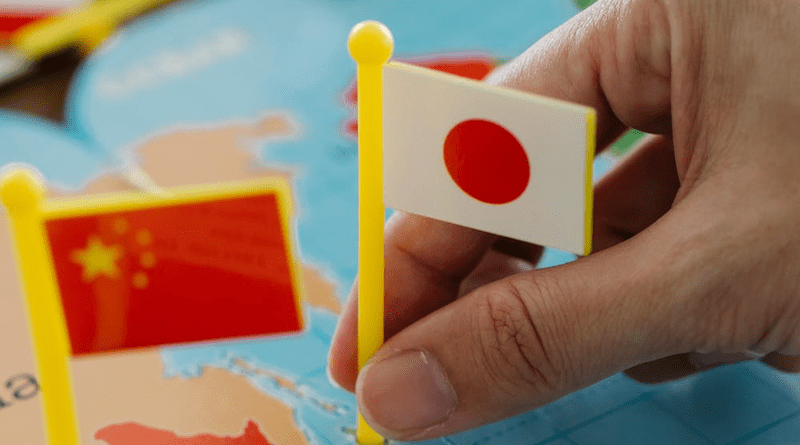Kishida-Xi Meeting: A Move To Reduce Frictions? – Analysis
By IPCS
By Dr. Sandip Kumar Mishra
At the sidelines of the Asia-Pacific Economic Cooperation (APEC) meeting in San Francisco in November, Prime Minister Fumio Kishida of Japan and President Xi Jinping of China held a sixty-five minute long meeting. Although the meeting didn’t suggest any substantial progress on contentious bilateral issues, both countries announced their commitment to a “strategic relationship of mutual benefit” and a high-level bilateral dialogue on economic issues. In a way, the meeting could appear “pointless,” but in fact its significance is more than what meets the eye.
The immediate background to the meeting is that China is looking for more Japanese business to help address its sluggish economy, and Japan’s immediate priority is to have China lifts the ban on Japanese seafood, which was imposed in August 2023. The blanket ban was imposed after the Japanese decision to release radioactive water from the Fukushima Nuclear Power Plant into the Pacific Ocean, which badly hit Japanese seafood exports to China. Its other priority is to resolve the issue of several Japanese businesspersons who are detained, investigated, or convicted in China. Since late 2014, around 17 Japanese nationals have been detained in China under the Chinese espionage law, and another five cases are pending investigation and conviction. Unfortunately, Beijing didn’t offer assurances to Tokyo on either issue. Further, according to reports, Japan also raised other issues such as Senkaku/Diaoyu Islands dispute; Chinese activities in the East China Sea and South China Sea; Taiwan; and human rights in Xinjiang and Hong Kong; however, none of these were discussed in detail.
Can this meeting still be called a success? Four aspects say yes.
The first important thing is that both leaders decided to meet in-person after almost a year. They last met in November 2023 in Bangkok, on the sidelines of the previous APEC meeting. Its significance relates to Kishida and Xi not meeting earlier in October, when Japan and China were observing the 45th year of their Peace and Friendship Treaty. In fact Xi didn’t share even a congratulatory message—this was exchanged only between Kishida and Chinese Premier Li Qiang. This was said to be a result of bilateral friction due to the Japanese radioactive water discharge and consequent Chinese ban on Japanese seafood. The celebration was thus a low-key affair. Other factors, such as existing gaps on regional security and economic issues, of course also contributed to these tensions.
The second important aspect of this meeting is the culmination of a shared interest between the two sides on addressing bilateral tensions. On 9 November 2023, Chinese Foreign Minister Wang Yi and Special Adviser to the Japanese Cabinet Takeo Akiba met in Beijing. Japan was also reportedly taking initiative to convene a summit meeting between the Kishida and Xi. In the subsequent period, China also made attempts to make the meeting happen.
Third, this was the first meeting to take place at the highest levels of leadership, after the revision of Japan’s National Security Strategy (NSS0 in December 2022. The NSS referred to China as the topmost threat—putting them ahead of North Korea. This takes particular significance as during the Shinzo Abe era, Japan hesitated to explicitly identify China as its top challenger. In the 19th Beijing-Tokyo Forum, Wang Yi said that in recent times, in mistakenly considering China an “unprecedented” and “major strategic challenger,” Japan’s perception of China has “noticeably regressed.” Where Japan considers it important to raise issues such as Taiwan and the East and South China Seas, China sees it as “Japan repeatedly overstepping.”
Fourth, bilateral economic tensions has hurt both countries and would have been a decisive contributor to the Kishida-Xi meeting taking place. China is worried that a large majority of Japanese businesses are gradually becoming disenchanted with China. According to the Japan External Trade Organisation (JETRO), only 27.7 per cent of Japanese firms are willing to expand their business in China. The reasons are both the sluggishness of China’s economy as well as its highhandedness.
Finally, the meeting should be seen in the context of US-China relations changing gears. US Foreign Secretary Antony Blinken visited China in June 2023; he was followed by the US Treasury Secretary Jane Yellen, making the bilateral attempt to reduce frictions quite clear. Xi Jinping also a four-hour long meeting with US President Joe Biden on the sidelines of APEC. The Japan-China outreach must be seen in this context.
Through its recent moves, Japan has made it obvious that it is open to either cooperating or contesting with China—depending on Beijing’s responses as well as changing major power relations. Some conservative commentators in the Japanese media are of the opinion that Kishida appears “afraid of antagonising” China, but in fact he and his administration have adopted a wise and deft approach to keep Japan’s options open.
Dr. Sandip Kumar Mishra is Associate Professor, Centre for East Asian Studies, SIS, JNU, & Distinguished Fellow, IPCS.

